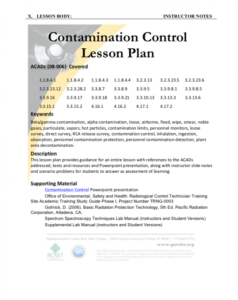RCNET ACAD 08-006 Crosswalk: 4.16 Chemistry Technicians - Radioactive Contamination Control

Program Description:
This material was published by the Regional Center for Nuclear Education and Training (RCNET) as part of a comprehensive crosswalk that links objectives of ACAD 08-006 with GP Strategies ABC Material, NUCP Surveyed Material, NANTeL resources, EPRI resources, web resources, and published material available to all RCNET partners. These accredited utility training programs are based off training and qualification guidelines (ACADs) published by the National Academy for Nuclear Training.
ACAD 08-006 is the Uniform Curriculum Guide for Nuclear Power Plant Technician, Maintenance, and Nonlicensed Operations Personnel Associate Degree Programs and includes five main curriculum areas: Core Curriculum, Discipline-Specific Curriculum for Nonlicensed Operators, Discipline-Specific Curriculum for Radiological Protection Technicians, Discipline-Specific for Chemistry Technicians, and Discipline Specific for Maintenance Personnel.
Contents:
This section of Discipline-Specific Curriculum for Chemistry Technicians (ACAD 08-006 4.16) focuses on explaining and applying the concepts related to radioactive contamination control.
Documents associated with ACAD 08-006 4.16 include one lesson plan and nine PowerPoint presentations. The 43-page lesson plan "provides guidance for an entire lesson with references to the ACADs addressed, texts and resources and PowerPoint presentation, along with instructor slide notes and scenario problems for students to answer as assessment of learning."
This material covers, more specifically: potential sources of radioactive contamination including work operations that can generate contamination; techniques for controlling the spread of contamination to personnel and equipment, including wearing protective clothing, packaging contaminated materials, using containment devices, controlling leaks from radioactive systems, and decontamination; the isotopes of primary concern for airborne radioactivity at the plant such as H-3, Co-58, Co-60, CS-134, CS-137, and I-131; the characteristic difference between particulate, iodine, tritium and noble gases and how they affect the method of detecting and controlling airborne radioactivity; ventilation and filtration systems; the purpose of using a continuous air monitor and identify situations in which continuous air monitors should be used; and more.
For orientation purposes ContaminationControlLessonPlan.pdf is included as a separate attachment and offers a sample of the type of material included in this curriculum.
Below is a list of the files contained within the .zip attachment. The size of each file is included in parenthesis.
4.16 Radioactive Contamination Control (11 files, 64.7 MB)
- Air Sampling (Air_sampling.pptx 3.4 MB)
- ALARA Engineers (ALARAforEngineers.ppt 28.1 MB)
- Biologic Effects of Radiation (BiologicalEffectsOfRadiation.ppt 3.8 MB)
- Contamination Control, Decontamination and Respiratory Protection (Contamination_Control,_Decontamination_Respiratory_Protection.pptx 1.7 MB)
- Contamination Control (ContaminationControl.ppt 8.3 MB)
- Contamination Control Lesson Plan (ContaminationControlLessonPlan.doc 457 KB)
- Protection Against Radiation (Protection_Against_Radiation.ppt 8.2 MB)
- Radiological Safety and Response (Radiological_Safety_&_Response.pptx 622 KB)
- Radiological Environmental Monitoring Program (RadiologicalEnvironmentalMonitoringProgram.ppt 9.4 MB)
- Radiation Protection Technician Initial Training: Engineering Controls (RPTechnicianTrainingEngineeringControls.ppt
About this Resource


Comments